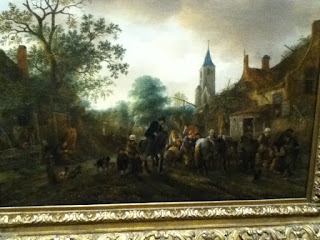 |
| The Cemar Trail along K Avenue NE, approaching Prairie Drive: 7.5 feet |
 |
| Sidewalk on Blake Blvd SE widens from 4 feet in the 1700 block to 5 feet above 18th St |
Urban designers commend wide
sidewalks for areas of heavy pedestrian traffic. David Sucher (2003: 97) notes: The
twelve-foot-wide sidewalk allows two couples to pass each other easily and with
only minimal and unconscious maneuvering and no interruption of the conversation.
He includes a picture taken in Alexandria, Virginia, showing two women walking
side-by-side in one direction, a third woman walking closer to the street, and
a man in a wheelchair coming the other direction. They’ll clearly pass each
other without needing to squeeze through or be at all awkward. Andres Duany et
al. (2010: 9.1) add, On active retail streets, a 15- to 25-foot width from
building to curb is not excessive, particularly if outdoor dining is a
possibility.
Reid Ewing and his students at the
University of Utah (Move This Way, cited below) note the problem that narrow
sidewalks can force pedestrians to walk into the street to get around obstacles
and other people…. Ideally, sidewalks should also be wide enough
to allow benches for older adults and families to stop and rest or relax. Generally,
two couples or two wheelchairs should be able to pass each other comfortably on
a sidewalk, which requires about 10 to 12 feet across.
Ewing et al. cite Seattle’s municipal code
as requiring sidewalks to be at least 12 feet wide; Knoxville, Tennessee,
requires 10 foot sidewalks in the South Waterfront District, but that includes
a five-foot planting zone. In Washington, DC, advocates note that Connecticut
Avenue used to have 12 foot sidewalks on both sides of the street, but in 1962 the
sidewalk on one side was narrowed to make room for a parking lot. At the time
of the post they were trying to get the original width restored (Caudill… if
you click on the link, be sure to watch the 1 ½ minute video trip down the
sidewalk).
Wide sidewalks are commended in the
“Best Practices and Design Guide” on the Federal Highway Administration website’s
Bicycle and Pedestrian Program: The width
of the sidewalk corridor is one of the most significant factors in determining
the type of pedestrian experience that the sidewalk provides…. Narrow sidewalk
corridors are unsatisfactory because they limit the number of pedestrians that
can use the area, require pedestrians to travel single file, and force
pedestrians to travel uncomfortably close to buildings and/or automobile
traffic…. Sometimes, narrow sidewalks do not provide enough clear space for
people who use walking aids or wheelchairs to travel down the length of the
sidewalk.
Wide sidewalks can already be found
around Cedar Rapids. In fact, the sidewalk along 1st Avenue in front
of Coe College is about 7.5 feet wide. Much of downtown features sidewalks of this width. Interestingly, some of the newer wide sidewalks are intended for both bicycles and pedestrians--for example, on K Avenue NE where the sidewalk was completed out to Prairie Drive as part of the CEMAR Trail. The wide sidewalk planned for Lindale Drive NE as part of the Collins Road project has a similar mix in mind.
Cedar Rapids's recent sidewalk construction initiative is welcome enhancement to our pedestrian infrastructure. Most are, of course, traditional five foot sidewalks. Are there places where foot traffic merits wider sidewalks? Along and around the high schools and middle schools, perhaps? Or, are there places where businesses as well as the general vibe would be helped by using wide sidewalks to invite walking?
 |
| 3rd St SE entering New Bohemia: 7.5 foot walking area with additional space for benches |
 |
| 7th Av SE in front of the new federal courthouse: 10 feet (?) |
 |
| 400 block of 1st St SE: 10 foot walking space, additional paved space for signs and lampposts |
 |
| 200 block of 3rd Av SE: 12 foot walking space (!) |
 |
| Sidewalk along 3rd Av SE is 10 feet by Greene Square, narrows to 5 feet above 5th St |
 |
| 7.5 foot sidewalk through Greene Square as you approach the public library |
SOURCES
Herb Caudill, “Bring
Back Cleveland Park’s Historic Wide Sidewalks,” Greater Greater Washington, 16 July 2013, http://greatergreaterwashington.org/post/19520/bring-back-cleveland-parks-historic-wide-sidewalks/
Andrew Duany and
Jeff Speck with Mike Lydon, The Smart
Growth Manual (McGraw Hill, 2010)
Move This Way: Making Neighborhoods More Walkable and Bikeable (ChangeLab Solutions, n.d.)
David Sucher, City Comforts: How to Build an Urban Village
(City Comforts Inc, 2003)
Priscila Pacheco and Lara Caccia, "How Public Spaces Make Cities More People-Oriented," The City Fix, 27 May 2015, http://thecityfix.com/blog/how-public-spaces-make-cities-more-people-oriented-priscila-pacheco-lara-caccia/ [not about sidewalks specifically, but about how spaces for public interaction make cities safer and more pleasant... not to mention more productive]





































